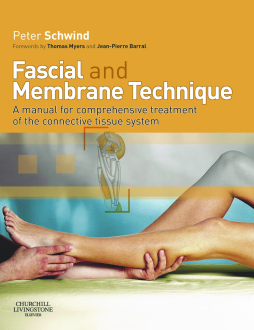
BOOK
Fascial and Membrane Technique E-Book
Peter Schwind | Thomas W. Myers | Jean-Pierre Barral
(2006)
Additional Information
Book Details
Abstract
The fascial and membrane technique developed by Peter Schwind combines the fundamental thoughts from Ida Rolf´s Structural Integration with concepts of osteopathy, creating a successful combination of form-stabilizing and mobilizing techniques. The book emphasizes diagnosis and treatment of the breathing patterns manifest in the myofascial system; minimalistic as well as global application joint techniques; visceral techniques in the myofascial context; special treatment techniques in the craniosacral area and care of the upper jaw.
- Includes comprehensive information on therapy from head to foot with descriptions of the anatomic correlations.
- Clearly describes the theoretical and practical principles so difficult concepts are easily understandable.
- Detailed, easily transposed instructions about treatments allow the reader to put the concepts into practice with ease.
- Photographically documented movements show real examples of topics discussed.
Table of Contents
| Section Title | Page | Action | Price |
|---|---|---|---|
| Front Cover | Cover | ||
| Fascial and Membrane Technique: A manual for comprehensive treatment of the connective tissue system | iii | ||
| Copyright Page | iv | ||
| Contents | v | ||
| Foreword to the German edition | ix | ||
| Foreword | xi | ||
| Acknowledgements | xiii | ||
| Chapter 1. Introduction | 1 | ||
| Chapter 2. Fundamentals | 5 | ||
| Terminology | 5 | ||
| Material properties of connective tissue | 6 | ||
| The significance of the tensegrity model | 7 | ||
| Plasticity: the malleability of connective tissue | 9 | ||
| Chapter 3. Principles of treatment in practice | 13 | ||
| Internal equilibrium of the therapist as a basis for observation | 14 | ||
| Presence of the therapist | 14 | ||
| Therapeutically efficient contact | 15 | ||
| The use of the hand-contact technique | 15 | ||
| Basic rules of fascial and membrane technique | 27 | ||
| Chapter 4. Form-oriented treatment techniques | 31 | ||
| 4.1 Breathing | 32 | ||
| 4.2 Myofascial treatment of scoliosis | 77 | ||
| 4.3 The shoulder girdle: the bridge to the upper extremity | 80 | ||
| 4.4 Upper extremity: upper arm, forearm, and hand | 93 | ||
| 4.5 Lower extremity: thigh, lower leg, and foot | 109 | ||
| Chapter 5. Special joint techniques | 135 | ||
| 5.1 Vertebral joints | 135 | ||
| 5.2 Treatment of intervertebral disk protrusions | 146 | ||
| 5.3 The sacrococcygeal joint | 153 | ||
| 5.4 Joints of the foot | 162 | ||
| Chapter 6. Visceral techniques in the myofascial context | 167 | ||
| Mobility and motility of organs | 168 | ||
| Summarizing aspects | 177 | ||
| Chapter 7. Treatment of the mandibular joint and the craniosacral system | 179 | ||
| Anatomy of the fasciae | 181 | ||
| Notes on diagnostics | 182 | ||
| Biomechanics of the mandibular joint | 183 | ||
| Treatment of the mandibular joint | 184 | ||
| Treatment after implantation of implants in the region of the maxilla | 189 | ||
| Anatomy of the palatine bone | 190 | ||
| Technique of the surgical intervention | 192 | ||
| Chapter 8. Treatment of the fascial and membrane system after whiplash | 197 | ||
| Mechanics of whiplash | 197 | ||
| Examination of whiplash | 198 | ||
| Treatment of whiplash | 203 | ||
| Chapter 9. Treatment after pregnancy and birth | 211 | ||
| Summarizing aspects | 215 | ||
| Concluding remarks | 217 | ||
| Bibliography | 219 | ||
| Index | 221 |
